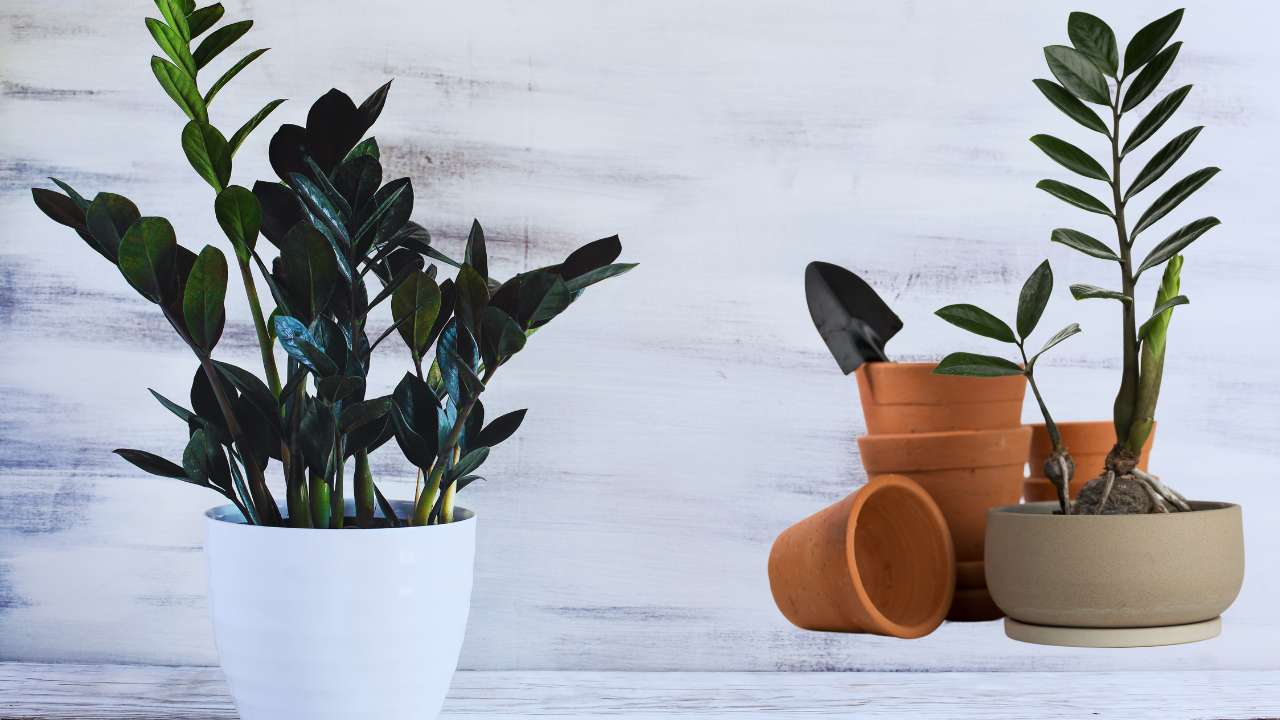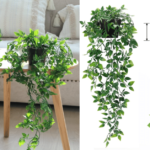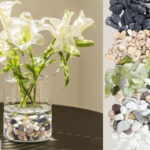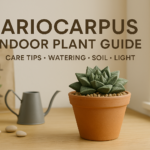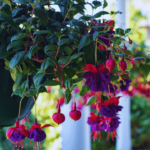The Black ZZ plant (Zamioculcas zamiifolia ‘Raven’) is a stunning indoor plant that has gained popularity for its deep, glossy black leaves and low-maintenance nature. It is visually striking and incredibly resilient, perfect for beginner and seasoned plant lovers. It thrives in various light conditions and needs minimal care.
Whether you’re looking to add a touch of elegance to your home or want a hardy plant that can handle a bit of neglect, the Black ZZ plant is a fantastic choice. It’s drought-tolerant, making it an ideal plant for those who occasionally forget to water. Its ability to adapt to low-light environments means it can thrive in spaces where other plants might struggle.
In this guide, we’ll cover everything you need to know about Black ZZ plant care, from light and watering requirements to propagation tips and troubleshooting common issues, ensuring your plant stays healthy and beautiful year-round.
What is a Black ZZ Plant?

The Black ZZ plant, scientifically known as Zamioculcas zamiifolia ‘Raven’, is a unique variety of the traditional ZZ plant. It features striking dark foliage that starts as a bright green and deepens into a rich, almost black colour as the plant matures. This slow-growing plant has a bold, modern appearance that makes it a favorite in contemporary interiors.
Origins of the ZZ Plant
The ZZ plant originates from Eastern Africa, particularly in Kenya and Tanzania. It thrives in arid environments, so it has evolved to store water in its thick stems and roots, making it highly drought-tolerant. Though commonly grown indoors worldwide, the plant’s hardy nature stems from its ability to survive harsh outdoor conditions.
Unique Characteristics of the Black ZZ
What sets the Black ZZ apart is its stunning foliage. While the standard ZZ plant has green leaves, the Black ZZ’s leaves start green and gradually turn into a deep, glossy black. This transformation gives the plant a mysterious and dramatic aesthetic, perfect for minimalist or bold interior designs. Additionally, it’s just as low-maintenance as the green variety.
Why is the Black ZZ Plant So Popular?

Here’s why the Black ZZ plant has become a favourite for many plant lovers:
Low Maintenance Appeal
- Minimal care: Requires little watering, making it ideal for beginners or people with busy schedules.
- Drought-tolerant: Stores water in its thick stems and roots, allowing it to survive prolonged periods without watering.
- Low light tolerance: Thrives in low-light conditions, perfect for dimly lit rooms or offices.
- Hardy and resilient: Can handle neglect and still look beautiful, surviving in less-than-ideal environments.
Aesthetic Benefits
- Striking dark foliage: Its deep, almost-black leaves add a touch of elegance and sophistication to any space.
- Modern design appeal: Complement contemporary and minimalist interiors with a unique, sleek appearance.
- Perfect for statement décor, the bold, glossy leaves make it a standout piece that enhances the visual appeal of any room.
- Versatile placement: Fits well in homes, offices, or indoor gardens, offering beauty and practicality.
How to Care for a Black ZZ Plant
Caring for a Black ZZ plant is simple, making it an excellent choice for all plant lovers. Here’s what you need to know:
Light Requirements
- Low to medium light: The Black ZZ plant thrives in low to medium light conditions. It can tolerate low light but will grow more slowly.
- Indirect sunlight: Bright, indirect sunlight is ideal for encouraging healthy growth. Avoid placing it in direct sunlight, which can scorch the leaves.
Watering Routine
- Infrequent watering: The Black ZZ plant stores water in its thick stems and roots, so it doesn’t need frequent watering. Water every 2–3 weeks, allowing the soil to dry out between waterings.
- Avoid overwatering: Overwatering can lead to root rot. Ensure the top inch of soil is dry before watering again.
Soil and Potting Needs
- Well-draining soil: Use a well-draining potting mix, such as one designed for cacti or succulents.
- Proper drainage: Ensure your pot has holes to prevent water pooling at the bottom.
Temperature and Humidity Preferences
- Room temperature: The Black ZZ plant prefers temperatures between 65–75°F (18–24°C).
- Low humidity tolerance: It can handle low humidity levels but thrives in moderate indoor humidity conditions. Avoid cold drafts.
Propagating the Black ZZ Plant

Propagating the Black ZZ plant is a straightforward process that can be done using two main methods: leaf cuttings and division. Here’s how to do each:
Leaf Cuttings
- Select healthy leaves: Choose mature, healthy leaves from the parent plant. Look for leaves that are free of damage or disease.
- Cut the leaf: Using a clean, sharp knife or scissors, cut the leaf into sections that are about 3–4 inches long. Each section should contain a vein for better propagation.
- Allow to callous: Place the cut sections on a paper towel in a warm, dry spot for a few days to allow the cut edges to callous over. This helps prevent rot.
- Plant the cuttings: Once the cut edges have dried, plant them in a well-draining potting mix, burying the cut end about an inch deep. Water lightly and place the pot in indirect sunlight.
- Wait for roots to develop: Keep the soil slightly moist, and in a few weeks, you should notice new growth as roots begin to form.
Division Method
- Choose the right time: The best time to divide your Black ZZ plant is during its growing season, typically in spring or early summer.
- Remove the plant from its pot: Carefully remove the plant from its pot, being gentle with the roots to avoid damage.
- Divide the root ball: Identify natural divisions in the root ball and use a clean knife to separate the sections. Ensure each division has a healthy root system and at least one stem.
- Report immediately: Plant each division in its pot with well-draining soil. Water lightly to settle the soil around the roots.
- Care for the new plants: Place the newly potted divisions in indirect sunlight and water as needed, allowing the soil to dry between waterings.
Read to know more: Are ZZ Plants Poisonous to Cats? Pet Owner Should Know
Common Issues with Black ZZ Plants
Black ZZ plants can encounter a few common problems despite their hardy nature. Being aware of these issues will help you keep your plant thriving.
Overwatering Concerns
- Root rot risk: Overwatering is the most prevalent issue affecting Black ZZ plants. These plants naturally store water in their thick stems and roots, so they don’t need frequent watering. Consistently wet soil can lead to root rot, causing leaves to turn yellow and potentially resulting in the plant’s death.
- Symptoms to watch for: Signs of overwatering include yellowing leaves, mushy stems, and a foul smell from the soil.
- Prevention tips: To avoid overwatering, let the top inch of soil dry out before watering again. Ensure your pot has drainage holes, and consider using a well-draining potting mix designed for succulents or cacti.
Pests to Watch Out For
- Potential pests: While Black ZZ plants are relatively pest-resistant, they can still attract common pests such as spider mites, mealybugs, and aphids. These insects feed on the plant’s sap, leading to weakened leaves and stunted growth.
- Signs of infestation: Look for small webs, cotton-like clusters, or discolored leaves to indicate pest issues.
- Treatment methods: You can use insecticidal soap or neem oil to manage pests. Regularly inspect your plant and wipe the leaves with a damp cloth to remove pests. Early detection is critical to preventing severe infestations.
Black ZZ Plant in Home Décor
The Black ZZ plant is a stunning addition to your indoor plant collection and an excellent way to enhance your home décor. Its unique dark foliage and architectural form can elevate any space. Here are some tips for incorporating the Black ZZ plant into your home design.
Placement Ideas
- Living Room Statement Piece: Place the Black ZZ plant in a decorative pot and set it in a corner of your living room. Its bold, glossy leaves will create a striking focal point and add a touch of modern elegance.
- Office Desk Companion: The Black ZZ plant thrives in low light, making it an ideal desk plant. Position it on your desk or a nearby shelf to bring a bit of greenery to your workspace.
- Bathroom Decor: The Black ZZ plant thrives in bathrooms because it tolerates humidity. Consider placing it on a windowsill or a shelf to liven up the space.
- Entryway Accent: Use the Black ZZ plant as an accent piece in your entryway. A tall plant can create an inviting atmosphere when guests enter your home.
Pairing with Other Plants
- Contrasting Colors: The dark foliage of the Black ZZ pairs beautifully with lighter-colored plants, such as pothos or peace lilies. This contrast can create a visually striking display.
- Textural Variety: Combine the Black ZZ plant with plants with different leaf shapes and textures, like ferns or snake plants. This adds depth and interest to your plant arrangement.
- Group Planting: Create a mini indoor garden by grouping the Black ZZ plant with other low-light-loving plants in a more prominent planter or a plant stand. This arrangement not only looks great but also makes care more accessible.
- Shelf Arrangements: Use the Black ZZ plant as part of a shelf display. Its upright growth habit can help balance trailing plants like a string of hearts or ivy.
Benefits of Having a Black ZZ Plant
The Black ZZ plant is not just a stunning addition to your home; it offers several benefits that enhance your living space.
Air Purification
- Improves air quality: The Black ZZ plant is known for its air-purifying properties. It can help remove toxins such as formaldehyde, xylene, and toluene from the air, promoting a healthier indoor environment.
- Increased oxygen levels: By absorbing carbon dioxide and releasing oxygen, the Black ZZ plant contributes to better air circulation, making your home feel fresher and more vibrant.
Enhancing Indoor Environment
- Aesthetic appeal: The striking dark leaves of the Black ZZ plant add a modern touch to any décor style, enhancing the overall ambience of your home.
- Mood booster: Having greenery indoors has been shown to reduce stress and increase overall well-being, making the Black ZZ plant a great companion for any room.
Where to Buy a Black ZZ Plant
Finding a Black ZZ plant is relatively easy, with several options available.
Local Nurseries
- Visit nearby nurseries: Local garden centres or nurseries often carry Black ZZ plants. This allows you to inspect the plant’s health before purchasing and receive advice from knowledgeable staff.
- Support local businesses: Buying locally supports small businesses and allows you to ask questions about care and maintenance directly.
Online Stores
- Convenience of online shopping: Many online retailers offer Black ZZ plants, providing a convenient option for those who prefer shopping from home.
- Wide selection: Websites like Amazon, Etsy, and speciality plant stores often offer a variety of sizes and pot options, making it easy to find the perfect plant for your space.
Potting and Repotting Black ZZ Plants
Proper potting and repotting are crucial for the health of your Black ZZ plant.
When to Repot
- Signs it’s time: Repot your Black ZZ plant when it outgrows its pot, indicated by roots growing through the drainage holes or a lack of growth.
- Timing: The best time to repot is spring or early summer when the plant is actively growing.
Best Practices for Repotting
- Choose the right pot: To allow for growth, select a pot that is 1–2 inches larger in diameter than the current pot.
- Use fresh soil: Opt for a well-draining potting mix suitable for succulents or cacti. This helps prevent water retention and root rot.
- Handle with care: Gently remove the plant from its pot, not damaging the roots. Place it in the new pot and fill it with soil, leaving some space at the top for watering.
Fertilizing the Black ZZ Plant
Fertilizing your Black ZZ plant can promote healthy growth.
Types of Fertilizers
- Balanced liquid fertilizers: During the growing season, use a balanced, water-soluble fertilizer with equal parts nitrogen, phosphorus, and potassium (e.g., 10-10-10).
- Slow-release options: For a more hands-off approach, you can also use slow-release granular fertilizers, which provide nutrients over time.
When and How to Apply
- Growing season: Fertilize during the spring and summer when the plant is actively growing, typically every 4–6 weeks.
- Application method: Dilute the fertilizer in water according to the package instructions and apply it to the soil, avoiding direct contact with the leaves.
Pruning and Cleaning Black ZZ Plants
Regular pruning and cleaning help maintain your Black ZZ plant’s health and appearance.
Why Prune Your ZZ?
- Promotes growth: Pruning encourages new growth and helps shape the plant, maintaining a fuller appearance.
- Remove dead or yellowing leaves: Regularly removing unhealthy leaves improves the plant’s overall health and prevents the spread of disease.
How to Prune Properly
- Use clean tools: Always use sharp scissors or pruning shears to avoid damaging the plant or introducing pathogens.
- Cut at the base: To maintain the plant’s aesthetics, trim dead or yellowing leaves at their base and avoid cutting healthy leaves.
Toxicity Concerns
While beautiful, it’s essential to be aware of the toxicity of the Black ZZ plant.
Pet Safety
- Mildly toxic: If ingested, the Black ZZ plant is mildly toxic to pets. Symptoms may include vomiting or diarrhoea. Keep the plant out of reach of curious pets to avoid accidental ingestion.
Human Interaction
- Skin irritation: The plant’s sap can cause mild skin irritation in some individuals. It’s best to wear gloves when handling the plant to prevent allergic reactions, especially during pruning.
Frequently Asked Questions (FAQ)
How often should I water my Black ZZ plant?
Water your Black ZZ plant every 2–3 weeks, allowing the top inch of soil to dry out between waterings. Overwatering is the most common issue, so it’s better to underwater than overwater.
Can the Black ZZ plant thrive in low light?
Yes, the Black ZZ plant is well-suited for low-light conditions. While it prefers bright, indirect light for optimal growth, it can thrive in dimly lit spaces, making it an excellent choice for offices and rooms with little natural light.
How can I tell if my Black ZZ plant is healthy?
Healthy Black ZZ plants have firm, glossy leaves that range from dark green to almost black. Signs of a healthy plant include upright growth and no yellowing or wilting leaves. If the leaves are soft or mushy, it may indicate overwatering or root rot.
Is the Black ZZ plant safe for pets?
The Black ZZ plant is considered mildly toxic to pets. If ingested, it can potentially cause vomiting or diarrhoea. To avoid accidental ingestion, it is best to keep the plant out of reach of pets.
When should I report my Black ZZ plant?
Report your Black ZZ plant when it becomes root-bound or outgrows its pot, typically during the spring or early summer. Signs include roots growing through the drainage holes or slow growth. Use a pot that is 1–2 inches larger in diameter than the current one with fresh, well-draining soil.
Conclusion
The Black ZZ plant is an exceptional choice for novice and experienced plant enthusiasts. Its stunning dark foliage, low maintenance requirements, and air-purifying qualities make it a valuable addition to any home. Whether you want to enhance indoor décor or improve air quality, this resilient plant fits the bill perfectly. By following proper care guidelines, including appropriate watering, lighting, and occasional pruning, you can enjoy the beauty of the Black ZZ plant for years to come. Embrace this unique plant and experience the joy it brings to your living space!

